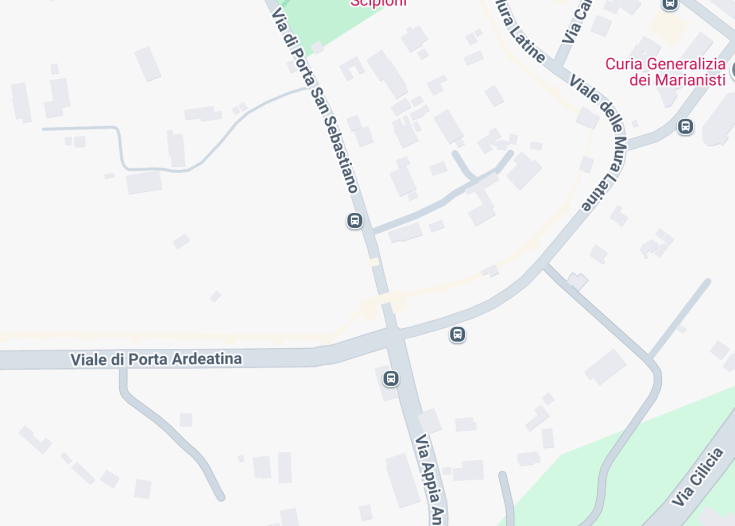The Arco di Druso stands as a fascinating remnant of ancient Roman architecture, offering visitors a glimpse into the city’s illustrious past. Known for its intricate design and historical significance, this structure once served as both a triumphal arch and an important aqueduct, symbolizing the engineering prowess of its era.
When visiting the Arco di Druso, be sure to explore the surrounding area of Porta San Sebastiano. The juxtaposition of ancient ruins with the modern city provides a captivating backdrop, making it perfect for photography and leisurely strolls.
For those planning their itinerary, consider visiting early in the morning or late afternoon. The soft, ambient light enhances the beauty of this historical monument, allowing visitors to appreciate its grandeur while avoiding the midday crowds.
Arco Di Druso in Rome, Italy
The Arco Di Druso, also known as the Arch of Drusus, is an ancient structure prominently situated along the Via Appia, one of Rome’s most revered ancient roads. It is characterized by its striking architectural features, which include two grand columns that frame the archway, presenting a façade that melds both functionality and artistry. The arch’s robust design showcases a simplistic yet dignified façade, built initially using travertine, now partially adorned with remnants of exquisite marble detailing. The arch rises to a height of approximately 7.21 meters and spans a depth of 5.61 meters, serving as both an aqueduct for the Antoniniano and a monumental gateway to the Via Appia. Its profound historical significance is encapsulated in how it reflects the grandeur of Roman engineering and their ability to repurpose structures for various civic needs throughout the centuries.
History
1st Century BCE – Epoca Giulio-Claudia
The origins of the Arco Di Druso can be traced back to the Julio-Claudian period in the 1st century BCE. Initially thought to be a triumphal arch dedicated to Drusus, the son of Livia and stepson of Augustus, this structure symbolized military triumph and was likely adorned with a wealth of decorative elements that accentuated its grandeur.
3rd Century CE – Renovation and Integration
In the early 3rd century CE, specifically during the reign of Caracalla, the arch was integrated into the newly constructed Antoniniano aqueduct. The structure of the arch was modified, transforming it into a functional part of the aqueduct system, which supplied water to the large public baths nearby. This adaptive reuse highlights the evolving nature of Roman architecture, where earlier monuments were often repurposed for subsequent generations.
5th Century CE – Defensive Additions
By the beginning of the 5th century, under Emperor Honorius, the arch underwent further modifications for defensive purposes. It was connected to the Porta San Sebastiano through massive walls, indicating the shift in its role from a monument honoring a figure to a component of the city’s fortifications. The remnants of these additions can be observed in the surrounding structures today, emphasizing the arch’s historical significance throughout various periods.
Exploring the Architecture of Arco Di Druso
Visitors to the Arco Di Druso can admire the architectural sophistication evident in its classical columns and the architrave supporting the tympanum. The remaining marble fragments offer glimpses of the original grandeur and craftsmanship that characterized Roman structures. The strategic placement along the ancient Via Appia allows for historical exploration, intertwining the legacy of Rome with the daily lives and journeys of its citizens.
Connection to Ancient Roman Culture
The Arco Di Druso serves as an emblem of Roman cultural identity and civic pride. Celebrated for its engineering prowess, it illustrates how Romans fused practical infrastructure with monumental art. This architectural fusion signifies Rome’s sophisticated urban planning, where aqueducts not only served functional roles but also became landmarks reflective of the empire’s monumental ideology.
General informations
Location
Located at the start of the ancient Via Appia, the Arco di Druso is easily accessible and lies just outside the historic center of Rome. It is situated near significant landmarks such as the Porta San Sebastiano and the ruins of the Terme di Caracalla, making it a great stop for sightseeing enthusiasts.
Address:
Via di Porta San Sebastiano, 13A, 00179 Roma RM, ItalyVisiting Information
The Arco di Druso can be visited freely as it is located in a public area of Rome. The best time to experience the monument is early in the morning or late afternoon when the light enhances its beauty and fewer tourists are around.
How to reach the Arco Di Druso
Car
The Arco di Druso can be easily reached by car. Parking is available at nearby facilities for a nominal fee. Keep in mind that traffic in Rome can be heavy, so plan accordingly.
| Route | Distance | Travel time |
|---|---|---|
| From Rome Airport (Fiumicino) | 30 miles (48Km) | 40 minutes |
| From Rome Termini (City Center) | 2.5 miles (4Km) | 15 minutes |
| From Vatican City | 3 miles (5Km) | 20 minutes |
Public Transport
Public transport provides a convenient way to reach the Arco di Druso. The closest metro station is Circo Massimo (Line B), from where it’s a short walk to the site.
| Route | Distance | Travel Time |
|---|---|---|
| From Rome Termini | 2.5 miles (4Km) | 25 minutes (metro + walk) |
| From Vatican City | 3 miles (5Km) | 30 minutes (bus + walk) |
Accessibility and Limitations
While the Arco di Druso is in a public area and accessible to all visitors, the surrounding environment may include uneven surfaces typical of ancient sites.
Accessibility
Limitations
- Limited seating areas around the monument.
- Expect crowds, especially during peak tourist seasons.
- Some areas may be inaccessible during maintenance or restoration work.
Notes to visitors
- Wear comfortable shoes suitable for walking on uneven surfaces.
- Stay hydrated, especially during hot weather.
- Respect the historical nature of the site by avoiding climbing on the structure.
Common questions
What are the best times to visit Arco Di Druso?
The best times to visit the Arco Di Druso are during the early morning or late afternoon when the light is particularly gorgeous for photography. Early mornings tend to be quieter, allowing visitors to enjoy the monument without the hustle and bustle of larger crowds. Additionally, visiting in the later part of the day can provide a stunning backdrop as the sun sets, casting beautiful colors across the site and enhancing the architectural features of this ancient structure.
In the cooler months, particularly from late autumn to early spring, the weather is often more comfortable for walking around and exploring the area around the Arco Di Druso. However, it is also advisable to check for any local festivals or events that may attract more tourists during particular times of the year, which can impact the overall experience. Regardless of the season, planning your visit during weekdays might result in fewer crowds compared to weekends.
Are there any nearby attractions to explore while visiting Arco Di Druso?
Yes, the Arco Di Druso is ideally situated near several notable attractions, making it easy for visitors to explore more of Rome’s rich history in one trip. Directly adjacent to the Arco Di Druso is the stunning Porta San Sebastiano, one of the best-preserved ancient city gates in Rome. This gate provides insightful context to the surrounding area and is worth a visit.
Not far from the Arco is the Circus Maximus, an ancient Roman chariot racing stadium that dates back to the 6th century BCE, giving visitors a glimpse into Rome’s storied entertainment history. Furthermore, the beautiful Appian Way (Via Appia) itself is an iconic ancient road lined with historical landmarks and monuments, ideal for a leisurely walk or cycling experience.
Lastly, consider visiting the nearby Baths of Caracalla. Being one of the largest and most impressive public baths in ancient Rome, it offers an extraordinary view into the Roman way of life. With so many sites close to the Arco Di Druso, visitors can immerse themselves deeply in Rome’s historical legacy.
What should I know about taking photos at Arco Di Druso?
Taking photos at the Arco Di Druso can be a delightful experience, provided you keep a few tips in mind for the best results. Firstly, it’s advisable to visit during the golden hours of photography, which are early in the morning or just before sunset, to capture the soft, flattering light that will enhance the beauty of the arch’s details.
Additionally, consider different angles to photograph the arch. From various positions along the Via Appia, you can achieve captivating perspectives. Wide-angle shots are particularly effective in showcasing the monument’s grand scale, while close-ups can highlight intricate details of the columns and decorations.
Be respectful of the surroundings and other visitors while taking pictures, especially since it can occasionally get crowded. If you’re keen on including yourself in the shots, bringing a tripod or asking a fellow visitor can help. Consider the inclusion of other nearby historical structures in your photos for added depth and context.
Is there a good spot for a picnic near Arco Di Druso?
Yes, there are several lovely spots for a picnic near the Arco Di Druso. The area around the ancient site offers a charming atmosphere with plenty of greenery and historical sights. One option is to head towards the nearby Park of the Appia Antica, which features lush landscapes and shaded areas ideal for enjoying a picnic.
Within the park, you can find numerous benches or grassy spots where you can comfortably spread a blanket. Additionally, the park encompasses various ancient ruins, providing a serene backdrop for your meal. The combination of historical ambiance and natural beauty makes it a perfect picnic location.
Remember to bring along some snacks or a light meal to enjoy, and consider packing reusable containers to minimize waste. The sounds of nature and the presence of monumental history around you can create a wonderfully memorable dining experience while visiting the Arco Di Druso.
What is the best way to learn about the history of Arco Di Druso while visiting?
To fully appreciate the history of the Arco Di Druso while visiting, consider using several different strategies to enhance your experience. First, acquiring a good guidebook or a comprehensive pamphlet available at local tourist information centers can provide essential historical context about the arch and its significance.
Another effective way to learn about the Arco Di Druso’s past is by joining a guided walking tour. Many local guides are well-versed in Roman history and can provide rich narratives and interesting anecdotes that may not be included in written materials.
Additionally, using audio guides or mobile apps dedicated to historical tours of Rome can greatly enrich your visit. These tools often allow you to explore at your own pace while providing curated content tailored to various sights along your route.
Finally, ensuring that you allocate time to simply soak in the atmosphere while observing the architectural features and the surrounding area while will help solidify your understanding of this historical landmark.

Is the Arco Di Druso in Rome (Rome), Italy worth visiting?
The Arco di Druso in Rome offers visitors a glimpse into the city’s rich history and architectural grandeur. Dating back to the III century A.D., this ancient structure is part of the larger Acquedotto Antoniniano and showcases the impressive engineering of the Roman Empire. Its design with two columns and a triangular tympanum highlights the classic features of Roman triumphal arches.
While it may not be as famous as other Roman landmarks, the Arco di Druso is a unique spot for history enthusiasts and those interested in architecture. It presents a quieter alternative to busier attractions and can fit well into a stroll along the Via Appia, enriching your experience of ancient Rome. Overall, it’s a worthwhile stop for anyone exploring this historic area.









